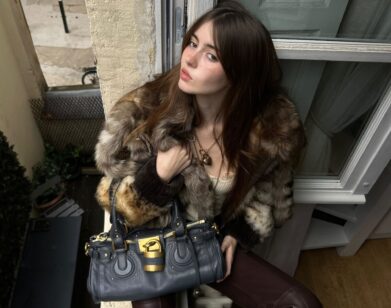Hong Hyejin Out of the Studio

Sculpture is not without pragmatic challenges, but then sculptors aren’t subject to the sensitive demands of dressing the mobile, fragile and temperamental human form, and then convincing a sustainable, sizable group of people to subscribe to their aesthetic sensibility. Building upon an her background as an artist, welding metal sculpture, furniture and jewelry, Seoul-based Hong Hyejin has gone a step further into fashion design, and found inspiration in additional layers of creative constraints.
Hong Hyejin’s first runway show for her three-year-old Studio K collection was presented during Seoul Fashion Week in the Kring art centre, as part of the Generation Next showcase for emerging designers. A favorite among the international press in the audience, the thirty-year-old Rhode Island School of Design graduate focused her collection on the design possibilities of a standard cube. The models in her catwalk show wore simple string necklaces ornamented with an abundance of blue wood cubes, and slipped their hands between the wing-like folds crossing over the front of a thick, grey wool clutch purse in the shape of a perfect square. Studio K’s dresses, skirts, tops and coats were more elaborate.
“It was all cut and fold, then cut and fold. I ended up with 25 pieces that fit the body perfectly, though I did discover over 60 possibilities. Many of the rejects didn’t have armholes or other obvious flaws. But then there were those that just didn’t quite look right,” she tells me as we share a meal at Miel, the canteen for Seoul’s fashion community. “It is funny though. I think the look of the collection had more to do with something within me, maybe that I don’t understand quite yet, than with my concept. The last collection that I did was entirely based on notions of drapery and fluidity. Yet it looked almost exactly the same.”
In the West, buyers will purchase entire collections on the basis of their faith in a designer’s vision, so that a collection can be successful with just one sympathetic buyer. By contrast, in Korea designers are offered space in stores for which they pay commissions to store owners, who can evict them if they don’t make sales quotas each season. Few designers have or can afford Hong Hyejin’s creative courage. She has been fortunate that her mother, a professor of fashion at the prestigious Kyoungwon University, is both a supporter and an inspiration.
“I am aiming for clients from their mid-20s onward,” she explains. “I want to make clothes for people who have tried lots of looks and have finally settled into their own personality. But I have found that my clothes appeal to people from their mid-teens to late forties. My garments are not right for people with bigger bodies, because they are very geometric and the layers might exaggerate the wrong parts. But I find that my clothes appeal to women within a wide age range.”
Leaving Miel we explore the nearby gallery complex, where we discuss the fact that every car in the parking garage or that we passed was either silver or black. I remark that Julian Opie seems incredibly popular in Seoul. Hong Hyejin responds by suggesting that Opie is a hot commodity because, “you can hang him in your house and immediately look modern.” I counter that the work looks “modern” because it looks sexy and risqué without being actually risky because: he creates slinky, suggestive stick figures.
Hong Hyejin corrects me. “Americans want to be sexy,” she says. “But Korean women want to be cute and pretty. It’s a generalization but I have the impression that most Americans do not want to be cute. They want to be sexy. But sexiness is not particularly popular here.” With her Marni-like cuts, intellectual tailoring, menswear inspired palette and sculpted but not necessarily revealing style, Hong Hyejin has rejected that ethos. With their strong, smart aesthetic, her clothes are far from cute.
The crisp and intellectual aspects of her aesthetic attracted the Fresh make-up label to invite Hong Hyejin to design uniforms for their employees. For one of the few markets where employees wear uniforms, Fresh’s founder Alina Roytberg was looking for a local designer with a comparable sensibility, and Hong Hyejin’s sharp, smart style was a match. Hyejin sees the connection as simpler than a shared artistically inclined clientele and perspective. She says, “Fashion is about emotion. The ideas are important, like my geometry is important to my process. But at its base, fashion is always about human feeling and human emotion.”






